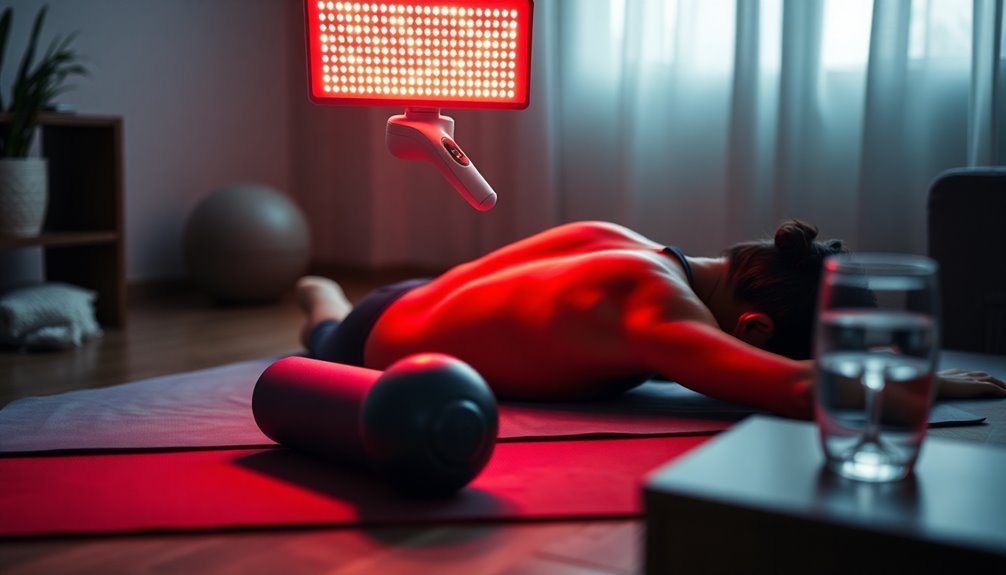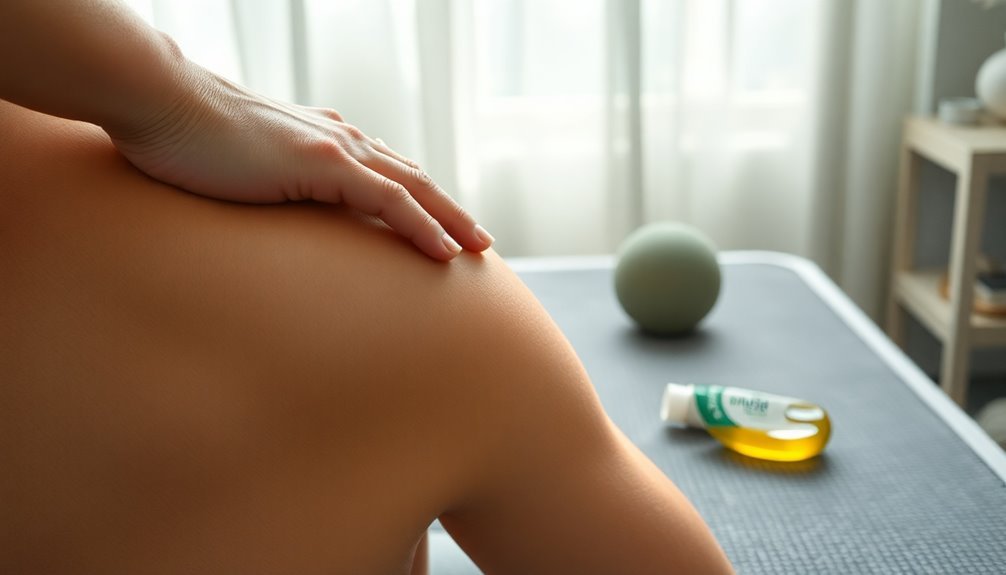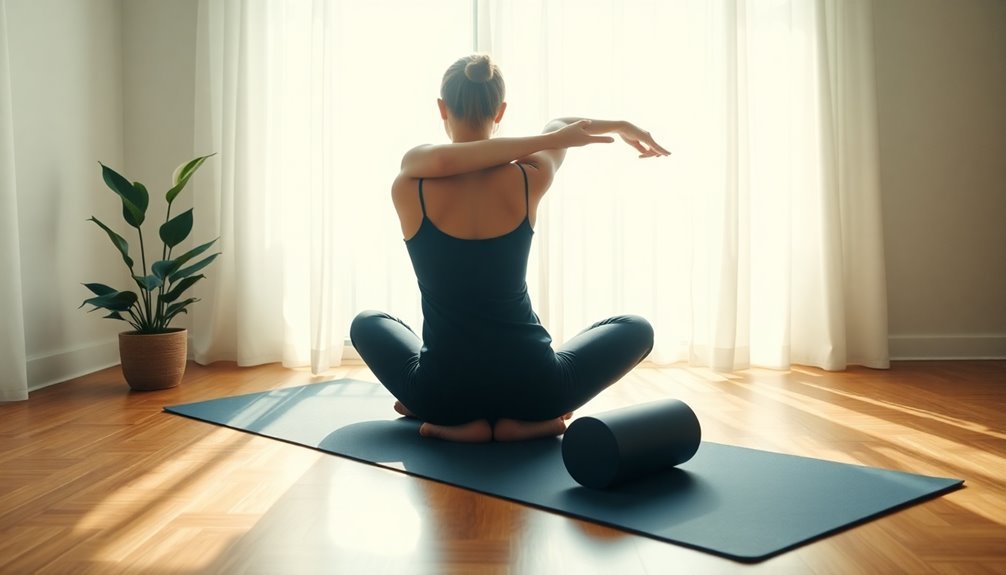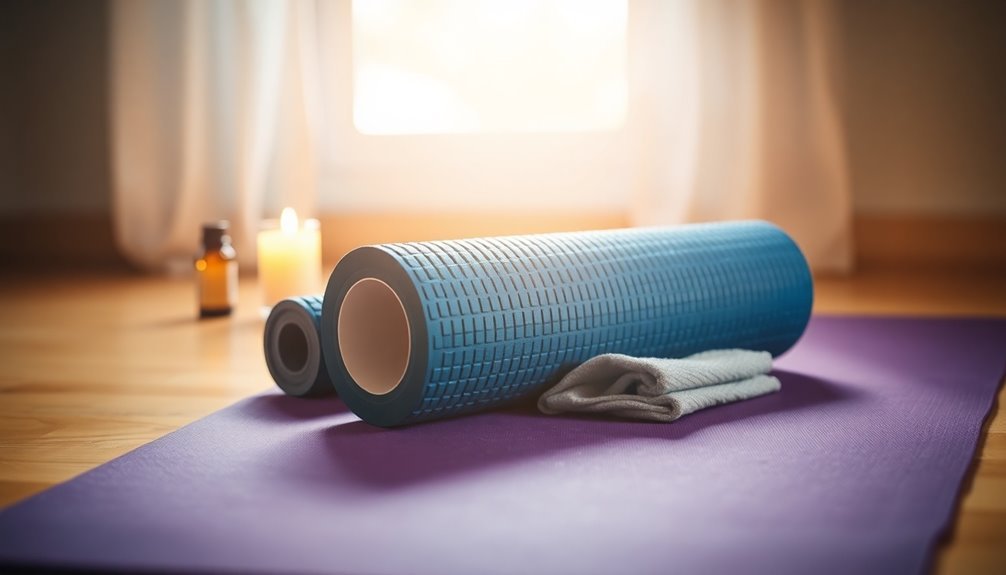You'll find fast relief from sore muscles with these proven at-home therapy techniques. Start with cold therapy using ice packs for 20 minutes every 4-6 hours during the first 48 hours. Then switch to heat therapy using warm towels or heating pads to boost blood flow. Perform gentle self-massage using long strokes or a tennis ball to target tight spots. Use a foam roller to break down muscle knots and improve flexibility. Finally, incorporate dynamic stretches when muscles are warm to enhance recovery. These core techniques are just the beginning of your muscle recovery journey.
Light Therapy For Muscle Recovery

Light therapy has emerged as a powerful, science-backed method for muscle recovery and pain relief. Using red and near-infrared light wavelengths between 630-1200 nm, this treatment accelerates healing through a process called photobiomodulation, which enhances your body's natural recovery mechanisms.
You'll get the best results by using light therapy both before and after workouts. Pre-workout sessions of 5-10 minutes prepare your muscles for exercise, while post-workout treatments of 10-20 minutes help reduce inflammation and soreness. Many athletes report faster training recovery when using light therapy consistently. Position the device 6-12 inches from your body for maximum penetration.
The science behind light therapy's effectiveness lies in its ability to boost ATP production and improve cellular energy. When the light penetrates your muscle tissue, it stimulates mitochondrial function, increases blood flow, and reduces oxidative stress.
This combination helps your muscles recover faster while decreasing pain and inflammation.
For effective at-home treatment, you'll want to verify you're using a certified device with adjustable intensity levels. If you have skin sensitivities or other medical conditions, consult your doctor before starting light therapy.
Regular sessions can substantially reduce recovery time and enhance your overall muscle performance.
Heat and Cold Treatment Methods
When it comes to treating sore muscles at home, heat and cold therapies offer two powerful yet distinctly different approaches to recovery. For acute injuries within the first 48 hours, you'll want to use cold therapy to reduce inflammation and numb pain. Apply ice packs or cold compresses for 20 minutes every 4-6 hours, but never directly on your skin.
After 48 hours, switch to heat therapy to increase blood flow and help flush out exercise byproducts like lactic acid. Heat therapy has been shown to reduce joint stiffness and muscle spasms, making it especially effective for tight muscles. You can use heating pads, warm towels, or moist heat applications for up to 20 minutes, three times daily.
| Treatment Type | When to Use | Benefits |
|---|---|---|
| Cold Therapy | First 48 hours | Reduces inflammation, numbs pain |
| Heat Therapy | After 48 hours | Increases blood flow, reduces stiffness |
| Moist Heat | Anytime after 48 hours | Better penetration, faster results |
| Professional Heat | Chronic conditions | Targets deep tissue |
Remember to protect your skin during both treatments. If you have diabetes or nerve damage, avoid direct heat application. For chronic muscle pain or arthritis, heat therapy is typically more beneficial, while acute injuries respond better to cold treatment.
Self-Massage Techniques That Work

Self-massage offers a powerful way to relieve muscle tension and soreness from the comfort of your home. You can use several effective techniques, starting with effleurage – long, gentle strokes that work well on your neck, shoulders, and thighs.
For deeper tissue work, use the heel of your hand or fist to apply sustained pressure on muscle knots for about 90 seconds until they release. Be sure to identify trigger points before applying pressure to ensure you target the right areas.
For hard-to-reach areas like your back, try the ball technique by placing a tennis ball between your back and a wall, then gently rolling it for 10-30 seconds. A foam roller works similarly and can target multiple muscle groups effectively.
When massaging your neck and shoulders, use gentle circular motions with your fingers, and don't forget your hands and wrists, which often hold tension.
Remember to breathe deeply during self-massage, as this helps your body relax and promotes tissue release. Limit sessions to 5-10 minutes to avoid over-aggressive pressure, and stop if you experience pain.
While some post-massage soreness is normal, it should resolve within 24 hours. If you're unsure about technique or experience new pain, consult a professional.
Essential Recovery Tools
Recovery tools have become essential allies in managing muscle soreness and promoting healing at home.
Foam rollers are particularly effective for breaking down muscle knots and adhesions, helping you achieve better flexibility while reducing post-workout pain. They're especially useful for targeting back pain and IT band issues if you're a runner. Incorporating them into your routine can help prevent overuse injuries and support long-term athletic performance.
Compression garments work wonders during and after exercise by improving blood flow and reducing muscle oscillation. You'll notice decreased recovery time when wearing compression socks, sleeves, or tights as they help minimize swelling and support muscle repair.
You'll want to incorporate both cooling and heating tools in your recovery routine. Start with ice packs immediately after exercise to reduce inflammation, then switch to heat therapy once the initial swelling subsides. The heat will help relax stiff muscles and enhance blood circulation.
For deep tissue relief, you can't go wrong with percussion massagers. These devices deliver rapid pulses that penetrate deep into muscle tissue, improving circulation and breaking up knots. You'll find them useful for both pre-workout warmups and post-exercise recovery, especially with their adjustable speeds and various attachments.
Movement and Stretching Strategies

Mastering the right movement and stretching techniques can dramatically accelerate your muscle recovery and reduce soreness. Start with a dynamic warm-up to boost blood flow through activities like jogging or jumping jacks, followed by dynamic movements such as lunges and arm circles.
When you're dealing with muscle soreness, incorporate active recovery workouts at 30-60% of your maximum heart rate. Swimming or water aerobics work well to improve circulation while minimizing joint stress. Your recovery routine helps deliver vital nutrients to damaged muscle tissue.
You'll want to complement these movements with myofascial release techniques using a foam roller, which helps break up adhesions in soft tissue.
Don't skip your cool-down exercises, as they're essential for preventing blood pooling and reducing fatigue. Combine static stretches, held for 10-30 seconds per muscle group, with dynamic stretching to enhance flexibility and muscle elasticity.
When foam rolling, move slowly and avoid direct pressure on bones and joints.
For ideal results, implement post-exercise stretching when your muscles are warm. This combination of movement and stretching strategies won't just ease your current soreness—it'll help prevent future muscle discomfort and improve your overall recovery process.
Frequently Asked Questions
How Long Should I Wait After Eating Before Doing Muscle Recovery Exercises?
You'll want to wait 1-2 hours after a full meal or 30-60 minutes after a snack before doing recovery exercises. If you've eaten something light, you can start sooner.
Can Certain Medications Interfere With Muscle Recovery Treatments?
Yes, medications like NSAIDs, statins, and metformin can interfere with your muscle recovery. You'll want to discuss your exercise routine and recovery plans with your doctor if you're taking these medications regularly.
Are Muscle Recovery Techniques Different for Elderly Versus Younger Adults?
Yes, you'll need different recovery approaches as an elderly adult. You'll require longer recovery times, gentler techniques, and more focus on safety. Your body's slower healing process means more emphasis on proper rest and nutrition.
Should I Continue Recovery Treatments During a Fever or Illness?
You'll want to pause most recovery treatments when you have a fever or illness. Rest is your best option – let your body focus on fighting the infection rather than healing muscles.
Does Altitude Affect How Quickly Muscles Recover From Soreness?
Yes, altitude substantially affects your muscle recovery time. You'll experience slower recovery at higher elevations due to reduced oxygen availability. Your muscles need more time to repair and rebuild in these conditions.
In Summary
You've now got the essential tools to treat sore muscles from the comfort of home. Whether you're using light therapy, alternating between heat and cold, practicing self-massage, investing in recovery equipment, or following smart stretching routines, these methods will help speed up your recovery. Remember to listen to your body and be consistent with these techniques for the best results in managing muscle soreness.





Leave a Reply